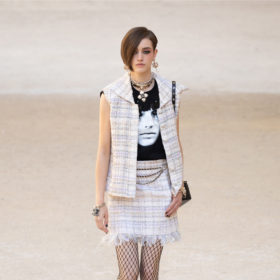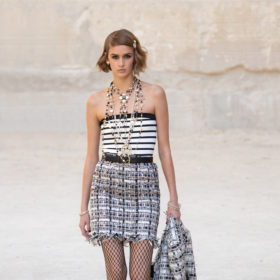Chanel Showed Its Iconic Tweed Suit In Eco-Conscious Fabric
A smart tweed suit is shorthand for Chanel. For its Cruise 2021/22 collection, the storied French fashion house gave the fashionable classic a sustainable makeover, introducing what it refers to as “eco-responsible fabrics.” Among the 108 materials found in the new Cruise season’s pieces, twenty-eight of them are GOTS (Global Organic Textile Standard) and GRS (Global Recycled Standard) certified; and the number includes four “eco-friendly” tweeds made by weaving studio Lesage that were used in the collection’s suits.
For a luxury brand that has been using the finest materials for decades, incorporating recycled fabrics is a big deal, and especially symbolic when you consider that it’s being used for its legendary tweed. But at a time when greenwashing is rampant, we wanted to know what it really means when a global leader like Chanel makes sustainability claims about its materials.

What does it mean to be GOTS- and GRS-certified?
To verify the quality of its eco-responsible fabrics, Chanel has received two designations: Global Organic Textile Standard (GOTS) and Global Recycled Standard (GRS) certification.
GOTS is considered the “worldwide leading textile processing standard for organic fibres, including ecological and social criteria, backed up by independent third-party certification of the entire textile supply chain.” Obtaining GOTS certification means addressing four key areas or production: using organic fibres, meeting ecological and social criteria, examining all processing stages and third-party certification. In short, GOTS has certified that these materials do come from organic farming, with dignified working conditions and respect for the environment upheld from start to finish.
GRS, meanwhile, focuses on tracking and verifying the content of the recycled material in the final fabric. Like GOTS, GRS takes into account the full supply chain, addressing traceability, environmental principles, social requirements, chemical content and labelling. Their standard is there to support companies wishing to confirm the recycled content of their products along with verifying that the social, environmental and chemical practices used to produce these products are responsible.

What does the use of sustainable fabrics mean for Chanel?
Chanel is a global leader in crafting heirloom-quality, made-to-last garments, which in itself goes a long way towards sustainability in fashion. It’s hard to imagine anyone who invested in a tweed suit would send it to a landfill along with the estimated 92 million tonnes of textile waste generated globally each year.
And preserving quality craftsmanship is paramount for Chanel. Over the years, it has acquired some 30-odd suppliers, a group of exceptional craft workshops it groups under its Maison d’Art label, including Lesage, silk weavers Denis & Fils and Scotland’s Barrie Knitwear. One of their more recent additions was Vimar, the Italian fancy yarn company they acquired in July 2020 and whose unique techniques it uses to create yarns for Chanel tweeds.
It makes sense that a brand so clearly focused on upholding high craftsmanship and material standards would extend that same care to its incorporation of recycled materials and eco-friendly fabric.

Is this collection groundbreaking?
Chanel reports that 28 of the 108 materials used in Cruise 2021/22 are considered “eco-responsible fabric”, which shakes out to about 25 percent. While still a minority of the collection’s entire fabric catalogue, this innovation is certainly a step in the right direction, especially taking into account that it’s only one part of the brand’s greater push towards sustainable operations.
In April, for example, Chanel announced a new partnership with the University of Cambridge Institute for Sustainability (CISL). It involves building an education and sustainability leadership program for Chanel management and teams, operational projects that will accelerate innovation within Chanel and support for students in CISL’s Masters in Sustainability Leadership program. Bringing Cambridge experts on board is no doubt an investment in the future.
“This new partnership reflects key pillars of our business transformation: from research and insights that deepen our understanding to finding tangible solutions that positively impact our supply chain and wider communities,” said Chanel chief sustainability officer Andrea d’Avack in a press release. “This is underpinned by educational initiatives that will help to embed a sustainability mindset to accelerate change.”

What other luxury brands are making sustainable changes?
The luxury fashion industry has been leaning into sustainable practices for some time. One high-profile example is Stella McCartney, who has long championed a cruelty-free ethos with her vegan line.
And legacy brands are on the same page. Take Hermès, which announced it would be using mushroom leather to create bags, which is lab-grown and uses less resources than traditional leather. And recently, a group of luxury brands that included Chopard, Kering and LVMH, which owns Tiffany & Co., revealed the launch of the Gemstones and Jewellery Community Platform, which aims to provide support and resources around responsible gemstone sourcing.
What does this mean for luxury fashion as a whole?
The fashion world has had great impact through its philanthropic support of worthy causes. At the same time, some brands have been reluctant to air their own dirty laundry. “They want consumers to think their products have all been made by Geppetto in his workshop in Florence. So they’re not going to talk about their workers in China, Romania, Turkey or North Africa, which would soil their image,” said Dana Thomas, author of Deluxe: How Luxury Lost its Luster, in a 2009 interview with Reuters.
When a leading brand like Chanel reinvents an icon using sustainable materials, it sends a message that luxury and sustainability can go hand in hand.
The post Chanel Showed Its Iconic Tweed Suit In Eco-Conscious Fabric appeared first on FASHION Magazine.